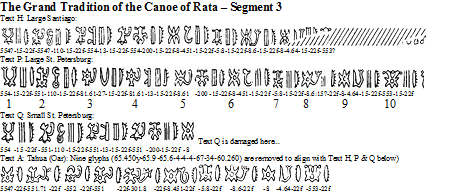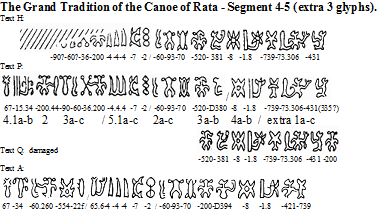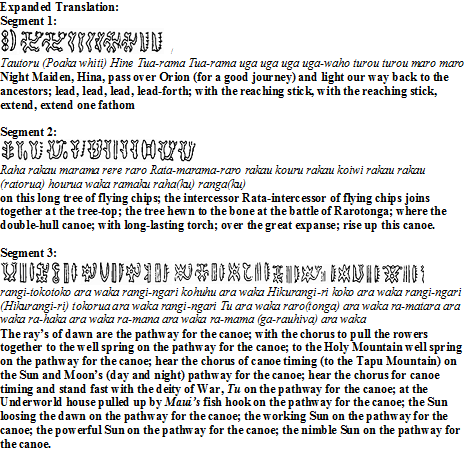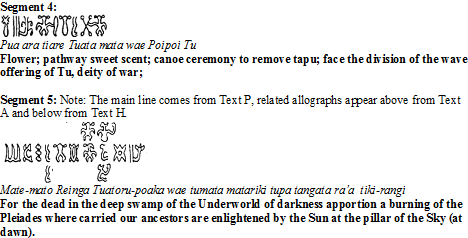Oct 14, 2025
Oct 14, 2025
The Canoe of Rata: Part 2

1 - rangi-tokotoko ara waka
2 - rangi-ngari kohuhu ara waka
3 - Hikurangi-ri koko ara waka
4 - rangi-ngari (Hikurangi-ri) tokorua ara waka
5 - rangi-ngari Tu ara waka
6 - raro(tonga) ara waka
7 - ra-matara ara waka
8 - ra-haka ara waka
9 - ra-mana ara waka
10 - ra-mama (ga-rauhiva) ara waka
The ray’s of dawn are the pathway for the canoe; with the chorus to pull the rowers together to the well spring on the pathway for the canoe; to the Holy Mountain well spring on the pathway for the canoe; hear the chorus of canoe timing (to the Tapu Mountain) on the Sun and Moon’s (day and night) pathway for the canoe; hear the chorus for canoe timing and stand fast with the deity of War, Tu on the pathway for the canoe; at the Underworld house pulled up by Maui’s fish hook on the pathway for the canoe; the Sun loosing the dawn on the pathway for the canoe; the working Sun on the pathway for the canoe; the powerful Sun on the pathway for the canoe; the nimble Sun on the pathway for the canoe.
Related Chant:
E ara rakau e! E ara rakau e!
A pathway for the canoe! A pathway for the canoe!
E ara inano e.
A path of sweet scented flowers.
E kopukopu te tini o kupolu.
The entire family of the birds of Kupolu.
E matakitaki, kareko! Oo
Honour you (Rata) above mortals.
There are 10 sections or verses to this portion of the Canoe of Rata chant that contains the pathway for the canoe:
1. Rangi-tokotoko ara waka:
the sky’s sunrays are a pathway for the canoe.

Rangi-tokotoko – from ra, sun + ngi, unfinished + toko toko, to support, to row together (Tregear. 1891. tokotoko). Rangi-nana from RANGI, sky + NANA, to feel for, to reveal = Rangi-nana, the sky is bent on revenge. Ara waka from a pathway for the Canoe. Wanawana means bristles as found on the canoe, may represent the Maori terms for rays of the Sun, toko or wana. As wana, these rays may be figurative of the deified ancestral priests or spirit medium called, Wananga. Together the three glyphs might read ‘a pathway for the canoe of a spirit medium’. Their memorial is the canoe raised up as a conduit for the spirit medium, called a Standing-Up-Rod.
Ihiihi/toko/tara, rays of the Sun (Tregear. 1891.). Rangi-tokano – a Moriori deity who pushes his father, Rangi apart from his mother. Rahi: great, broad – as in broad pathway for the canoe. Myth: Rahirahinga – temples of the forehead where hanging down from deity (rays of Sun). Rangi-whaka-nohinohi – the highest heaven.
2. Rangi-ngari kohuhu ara waka:
the sky chant to pull rowers together toward the well-spring
(of the ancestors) on this pathway for the canoe.

Rangi-ngari from RA, Sun + NGI, unfinished + NGA, to breathe + RI/rima, the hand = a division or portion of a song (Tregear. 1891. Rangi) to pull rowers together in timing (Tregear. 1891. ngari). Kohuhu from KO/koko, to dig a hole + HUHU, concave = a well spring (Rangi-riri is the fountain on the ocean floor where all fish spring forth. This fountain is likened to the well Rata severed the head of the Underworld deity who killed his father. It is here the Table of Rata on the ocean floor the Underworld is broken and the fish boil up to the surface. In Richard Taylor’s Te Ika a Maui, on New Zealand and Its Inhabitants, the ancient rowers’ chant of the Aotea canoe also uses rangi with plenty of chorus:
Kite rangi, hapainga;… to the heavens raise it (a hoe, paddle)
Ki te rangi tu te koko.… to the heavens, lift it.
Here the rowers paddle is an offering raised on high and plunged into the sea. The chant also uses ara, or pathway in multiply chorus.
Hapai and koko mean to raise up. Hapainga, ko or koko are an implement for digging, if in water, then possibly a paddle. The idea of breaking the waves, of rising and falling as a team of rowers is apparent in these past two glyphs. Legend states that Rainbow’s slipknot freed the fish long enough to stall the fairies until sunrise. Then they noticed Kahukura and fled, leaving him with their fish and fish net. Here is the source of Polynesian fish net technology. Is this kohuhu slipknot, where the fish are freed, not the same kohuhu fountain on the ocean floor where all fish are born? Rangiriri is the fountain on the ocean floor producing all fish (Tregear. 1891. Rangiriri). At this well spring, Rata's enemy that killed his father stuck his head and there Rata noosed him.
3. Hikurangi-ri koko ara waka:
Toward the Sacred Mountain lift your paddle
on the pathway for the canoe.

Hikurangi-ri koko from HIKU, tail + RANGI, Sun/sky + RI/rima, a hand + KOKO, concave = the sacred mountain spring (in the sea producing all fish) (Tregear. 1891. Hikurangi). Ri works as an abbreviation for ngari, a canoe timing chant and may also by itself be a sacred screen making Tapu what appears on the other side of the hand. Thus, the mountain spring is sacred and restricted from common use. Guy identifies verse 3 as contained only on Text A and P (Guy. 1985. P. 381). It makes sense when Text P, verse 2 and 3 read as follows:
Sing of the well spring of the pathway for the canoe,
At the sacred mountain well spring of the pathway for the canoe.
In Text A, the glyphs appear as a moon being raised over the Sun. Logographically, this coincides with both the Aotea Canoe chant with koko meaning lift and a play on the Tokorua of verse four below. Tokorua in verse four is intended as a syllabic pun for Sun and Moon.
4. Rangi-ngari tokorua (Hikurangi-riri) ara waka:
Chorus of the rowers divided both night and day
(on the Sacred Mountain) on the pathway for the canoe.

Rangi-ngari (Hikurangi-riri) toritori from TO/toko, pole + RI/riki, fragment = toritori, to divide. Tokorua from TOKO, pole + RUA, two = tokorua – nga tokorua a Taingahue, “The Twins of Taingahue” are the sun and moon (Tregear. 1891. Tokorua). Also, Nga tokorua a tongotongo: the two children of Tongotongo, the Sun and Moon (Tregear. 1891. Ra). Hikurangi is the first place where the dawn sun touches the earth.
5. Rangi-ngari rari Tu ara waka:
The chorus for the rowers who shout for Tu,
the deity of war, to conquer the pathway for the canoe.

Rangi-ngari rari Tu. Rari from RA, the Sun + RI/rima, the hand = to make a loud noise. Tu from TU, to stand = Tu of the Angry Face, deity of war. Taylor’s Aotea Canoe Chant, Tu is placed in Kei te aweawe nui no Tu, the great expanse (or multitude) of Tu.
6. Raro(tonga) ara waka:
(Maui) the light, draws up the Underworld habitation
on the pathway for the canoe.

Raro from RA, the Sun + RO/Rou, a fish hook = the bottom. Rarotonga the house at the bottom of the sea hooked by Maui, and pulled up land for humanity. The Rarotonga house belonged to Hine-nui-te-po, goddess of the Underworld.
The Underworld powerful Ru was then tossed up by Maui and stuck on the belly of the sky where he rotted. His bones fell and as the stones across the land, represented perhaps by the Easter Island moai and akin to the Setting Up of Rods and Pure rituals. This canoe is the pathway of Tane that the Woodland fairies carried suspended in the air on a pathway to the sea. The Moai of Easter Island are the pathway of the ancestors.
7. Ra-matara ara waka:
where the sky meets the Underworld
loosen the dawn providing a pathway for the canoe.

Ra-matara from RA, the Sun + MATA, the eyes + RA/ara, a pathway = to loosen or set free the Sun (an incantation for the dawn). Rangimata from RA/rangi, the Sun/the sky + MATA, the eyes = the canoe of the Moriori migration.
8. Ra-haka-ara waka:
let the Sun work on the pathway for the canoe.

Ra-haka from RA, the Sun + HAKA, the verbal hand sign for work or action = the work of the Sun.
9. Ra mana ara waka:
the Sun is our source of power on the pathway for the Canoe.

Ra mana from RA, the Sun + MA/mahina, the moon + NA/naunau, to feel for (as a mosquito), to reveal = the power of the Sun.
10. ra-mama ara waka:
The sun is nimble on the pathway for the canoe

Ra-mama from RA, the sun + MA/mata, the eyes + MA/mata = ra-mama, the light
and nimble sun. Also ga-rauhiva from RA, the sun + GA-RAUHIVA, twins = the twins (Morning and Evening Star).
Ra mana ara waka: the Sun is the spiritual force on the pathway for the Canoe.
Guy makes an interesting observation in the statistical analysis of glyph 22f (Guy. 1985. P. 381), the plausible ‘canoe’. In Text A, the bristles appear to alternate from left to right in most of the 10 glyphs. This may be a representation of the paddles alternating or the Chief of the canoe swinging the timing stone from left to right as he chants the timing song. In Tablet P there appears to be a variation of glyph 22f from pairs of ‘biconvex’ or half size ‘canoes’ to pairs of ‘meniscus’ full size ‘canoes’ (Guy. 1985. P. 381). There may be a play on ‘extra’ syllables at use here. It is plausible that the bristles (wanawana), stand for the wananga priestly medium or deified ancestor of this canoe. In this case, Rata and/or the recently deceased. Regardless of the meaning, Guy’s finding is an important clue towards the rediscovery of more than one rongorongo school or leading teacher at work on the island (Guy. 1985. P. 387).

Seg. 4: 1a-b- Pua ara tiare -2- Tuata -3a-b- mata wae -3c- poipoi Tu
Seg. 5: 1a- mate/mato -1b- Reinga -1c- Tautoru/Poaka -2a- wae -2b- tumata -2c- matariki -3a- tupa -3b- tangata -4a- ra’a -4b- tiki-rangi
Extra glyphs: -1a- taniwha (punga-mako) -1b- tuata-tahaua-ata -1c- atu tangaroa
Seg. 4: Flower; pathway sweet scent; canoe ceremony; face the division; of the wave offering of Tu;
Seg. 5: for the dead in deep swamp Underworld of darkness at the apportioning of kindling for the souls gathered at the Pleiades; to carry the man to the Sun at the pillar of the Sky (at dawn); where the water monster (shark) (is defeated) by the canoe releasing ceremony and nimble souls supported by Lord (of the sea) Tangaroa.
Related Chant(s):
A Pathway for the Canoe…A pathway of sweet scented flowers…
Seg4.1. pua ara tiare – flower pathway sweet scent.
pua ara tiare – flower pathway sweet scent.
Horley presents a possible parallel to this glyph 067 as glyph 133 and also attributes glyph 055b and 068 as potentially synonymous, giving reason to further study the variations of Barthel’s glyphs 162-176. (Horley. 2009. P. 260).
Here is the line of the Pathway of the Canoe: E ara inano e – the pathway of sweet scented flowers. Tiara means a traveller and tiari means to hang. The scent glyph is a hanging of resin off of sweet smelling plants enabling the spirit of the deceased to ‘travel’ to the purified celestial realms of the ancestors.
2.  Tuata – from TU, to stand, god of war and ATA, spirit or shadow = Tuata, the ceremony for removing tapu from a canoe.
Tuata – from TU, to stand, god of war and ATA, spirit or shadow = Tuata, the ceremony for removing tapu from a canoe.
3a.  Mata wae – face the division.
Mata wae – face the division.
Mata wae from MATA, the eyes + wae, the foot = face the division.
3c.  Poipoi Tu – from poipoi, ball game or wave offering and Tu, war god.
Poipoi Tu – from poipoi, ball game or wave offering and Tu, war god.
This is a wave offering to Tu, the war god. If Tu is our protective spirit from glyph 2 above, it is only right to honor him with a wave offering. The wave offering is also common to the pathway for the canoe chant in the karakia or pure prayers of the Maori.
Seg.5.1a.  Mate – death; mato – a deep swamp
Mate – death; mato – a deep swamp
Mate – from maripi, knife + tengi, three = death. Mato – from maripi and toru (three) = a deep swamp. Matoka-rau-tawhiri is the wife of Wahieroa. In her pregnancy with Rata, she desired the fairies, koko birds or tui birds and her husband died trying to get them. Perhaps she is the deep swamp or Reinga or Po, or queen of it.
1b-c.  Reinga Po – the Underworld of Darkness.
Reinga Po – the Underworld of Darkness.
Reinga Tautoru Poaka – from Rei(nga), the reimiro neck ornament + Tautoru, Orion + Poaka from PO/poipoi, balls + AKA, root = Poaka, Rigel. Reinga and Po are both terms for the Underworld.
2a-c wae tumata matariki– Apportion the burning of the Pleiades, the gathering place of the deceased. The Pleiades, Matariki rose at the burning time for stars, which was dawn. To align their clan with the stars, the tohunga priest would open the maori oven at this time so that the smoke would rise and feed the Pleiades, which was considered in a weakened state. As Matariki rose, the planting season would begin.
wae tumata matariki– Apportion the burning of the Pleiades, the gathering place of the deceased. The Pleiades, Matariki rose at the burning time for stars, which was dawn. To align their clan with the stars, the tohunga priest would open the maori oven at this time so that the smoke would rise and feed the Pleiades, which was considered in a weakened state. As Matariki rose, the planting season would begin.
3a-b tu-pa tangata ngari from TU, to stand + PA, deity of food consumption (marked by round belly) or PA, to reach one’s ears (marked by sagging ear) = tupa, to carry; tangata the man.
tu-pa tangata ngari from TU, to stand + PA, deity of food consumption (marked by round belly) or PA, to reach one’s ears (marked by sagging ear) = tupa, to carry; tangata the man.
4a-  ra’a tiki-rangi – the Sun, the pillar of the sky. Dawn as it appears to make a pillar reflecting off of the water.
ra’a tiki-rangi – the Sun, the pillar of the sky. Dawn as it appears to make a pillar reflecting off of the water.
Extra glyphs: -1a- taniwha (punga-mako) – a water monster or shark.
taniwha (punga-mako) – a water monster or shark.
1b- tuata-tuhaua-ata  – tuata from TU, to stand + ATA, spirit/shadow = tuata, a ceremony for raising tapu from a new canoe. Tuhaua-ata from TU, to stand + HA/haka, to work (from the hand) + U/ueue, a support + ATA, spirit = tuhaua-ata, quick, nimble spirit.
– tuata from TU, to stand + ATA, spirit/shadow = tuata, a ceremony for raising tapu from a new canoe. Tuhaua-ata from TU, to stand + HA/haka, to work (from the hand) + U/ueue, a support + ATA, spirit = tuhaua-ata, quick, nimble spirit.
Tuwhakararo is the son of Rata. Tuwha means to divide or apportion. Whakaue-kaipapa is an ancient ancestor and father of Kopako and Tupa.
1c- atu tangaroa – from ATU, turn around + TA/taha, side + NGA, to breathe + ROA, long = atu tangaroa, Lord Tangaroa, the deity of the sea and the deity of war.
from ATU, turn around + TA/taha, side + NGA, to breathe + ROA, long = atu tangaroa, Lord Tangaroa, the deity of the sea and the deity of war.


Matariki was the constellation where the ancestors gathered from the grave. It rose in mid-winter to the laments seasoned with a joyful anticipation for the New Year. Matariki’s rising occurred at what was called the burning rays of the Sun, meaning dawn.
Extra Glyphs: Note: Text P appears in the centre, related allographs appear above from Text A below from Text Q.

taniwha (punga-mako) tuata-tahaua-ata atu tangaroa
where the water monster (shark) (is defeated)
in this pure ceremony to remove tapu from the canoe
by nimble spirits supported by Tangaroa (deities of the sea).
(Note: in the ceremony the crew eat the fish offering and as in the canoe karakia presented by Shirres above, the deity eats his enemy, the enemy is symbolized by a fish (death as a giant fish or taniwha).
Conclusion:
Guy’s analysis and ordering of the Grand Tradition complements the mythological background of the Canoe of Rata rowers timing chant plausibly deciphered above. Rata advocates for the ancestors by providing a vessel to break the waves of death and rise up carried on this celestial pathway to the stars. Under the broken Table of Rata from this spiritual volcano of death come a shoal of fish, which represent all people. The birdmen are the elect commissioned to help gather the fish. At Sunrise, when all mysteries are brought to light, even the elect admit their own helplessness when standing face to face with Makemake, the Creator. Yet, in the Raising of the Rods, the Polynesian birth and death ceremonies, we find an Advocate and Mediator in Rata, who builds a vessel for us and our ancestors to break the waves of death and rise up this divine pathway of Rakau, the Canoe, the Sacred Tree of Life, of Maui, who raises and lowers the ceremonial oars with us on the oceans golden-red pathway toward the dawn.
Acknowledgements:
To the Indigenous sages who wrote the Rongorongo Tablets, may their humble and noble voices be heard. Also to those who have worked tirelessly to listen to those ancestors in order to discover that we are all Indigenous to Mother Earth. And to those of you who have pulled the excalibur from the stone before all your accusers in order to hew down the tree of the passing world and prepare your migration canoe toward the Shift just over the horizon.
References:
[1] Guy, J. B. M. (1985). On a Fragment of the ‘Tahua’ Tablet. The Journal of the Polynesian Society. Vol. 94. No. 4. Pp. 367-388.
[1] Guy (1985). Ibid. P. 367.
[1] Guy (1985). Ibid. P. 379.
[1] Shirres (1996). Ibid. Website: Maori Theology.
[1] Shirres (1996). Ibid. Website: Maori Theology.
[1] Wolfe (1945). Ibid. 30. Thomson, W. J. (1889). Te pito te henua or Easter Island. Smithsonian Report. Pp. 447-552.
[1] Shirres (1996). Ibid. Website: The Karakia for the canoe.
[1] Taylor, R. (1855). Te Ika a Maui, on New Zealand and its Inhabitants. Wertheim & Macintoch.
[1] Shirres (1996). Ibid. Website: The Introductory Rite – the Setting Up of the Rods.
[1] Shirres (1996). Ibid. Website: Haapai ake au i taku – a karakia for the canoe.
[1] Shirres (1996). Ibid. Website: The Karakia for the canoe.
17-Jan-2013
More by : Anonymousfor JoshuaMessiah